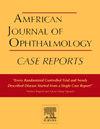Black flashes (dysphotopsia) as a symptom of vitreo-papillary traction in evolving posterior vitreous detachment – An optical coherence tomography case series
Q3 Medicine
引用次数: 0
Abstract
Purpose
We present three cases of evolving posterior vitreous detachment (PVD) in which patients experienced black flashes, known as negative dysphotopsia (ND), and were found to have vitreo-papillary adhesion at the optic nerve head.
Observations
A 53-year-old female with a history of right rhegmatogenous retinal detachment (RRD) described initial symptoms of black flashes. Seven years later, she developed similar symptoms in the left eye and was diagnosed with PVD. OCT demonstrated vitreo-papillary adhesion.
A 47-year-old male with a history of pseudophakic RRD in the left eye 5 years previously presented with black flashes in the right eye on eye movements. He was found to have PVD and RRD after 5 months of these symptoms. OCT revealed separation of the vitreous from the macula with attachment on the optic disc.
A 51-year-old male developed ND which were replaced by white flashes after 3 weeks. A week later he was diagnosed with PVD and a retinal tear with OCT evidence of vitreo-papillary traction.
Conclusions and importance
Evolving PVD may present with ND before classical symptoms such as positive dysphotopsia and floaters, particularly in cases with vitreo-papillary adhesion/traction.
黑色闪光(光线不佳)作为玻璃体-乳头状牵拉的一种症状在发展后玻璃体脱离-光学相干断层扫描病例系列
目的:我们报告了3例发展中的后玻璃体脱离(PVD),患者出现黑色闪光,称为阴性光失视(ND),并发现视神经头有玻璃体-乳头状粘连。患者53岁,女性,有右侧孔源性视网膜脱离(RRD)病史,首发症状为黑色闪光。七年后,她的左眼出现了类似的症状,并被诊断为PVD。OCT显示玻璃体-乳头状粘连。47岁男性,5年前左眼有假性晶状体RRD病史,眼球运动时右眼出现黑色闪光。这些症状出现5个月后被发现有PVD和RRD。OCT显示玻璃体与黄斑分离,视盘附着。51岁男性患ND, 3周后出现白斑。一周后,他被诊断为PVD和视网膜撕裂,OCT显示有玻璃体-乳头牵引。结论和重要性:发展中的PVD可能在典型症状(如阳性呼吸障碍和飞蚊症)出现之前就出现ND,特别是在有玻璃体-乳头状粘连/牵引的病例中。
本文章由计算机程序翻译,如有差异,请以英文原文为准。
求助全文
约1分钟内获得全文
求助全文
来源期刊

American Journal of Ophthalmology Case Reports
Medicine-Ophthalmology
CiteScore
2.40
自引率
0.00%
发文量
513
审稿时长
16 weeks
期刊介绍:
The American Journal of Ophthalmology Case Reports is a peer-reviewed, scientific publication that welcomes the submission of original, previously unpublished case report manuscripts directed to ophthalmologists and visual science specialists. The cases shall be challenging and stimulating but shall also be presented in an educational format to engage the readers as if they are working alongside with the caring clinician scientists to manage the patients. Submissions shall be clear, concise, and well-documented reports. Brief reports and case series submissions on specific themes are also very welcome.
 求助内容:
求助内容: 应助结果提醒方式:
应助结果提醒方式:


